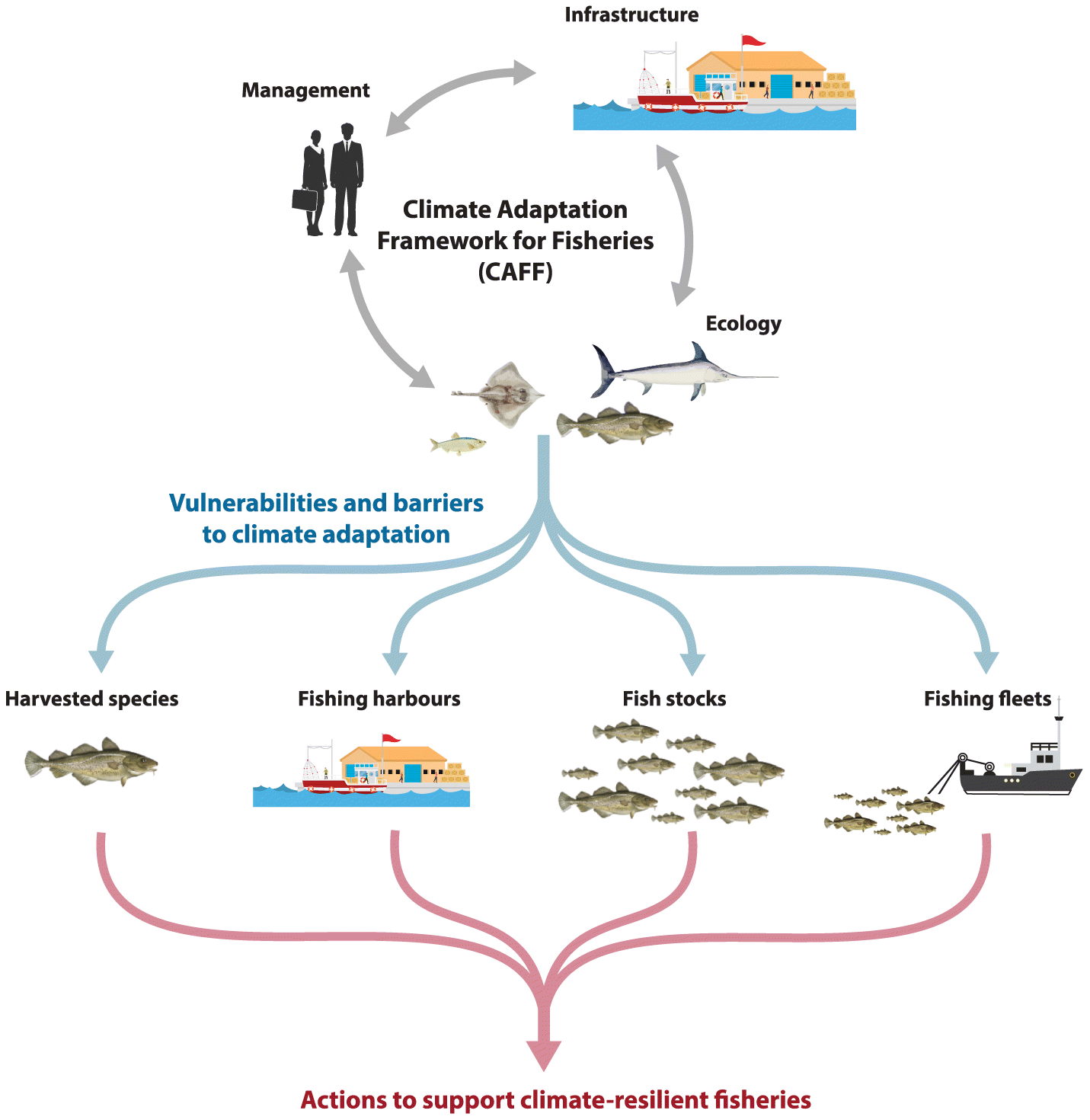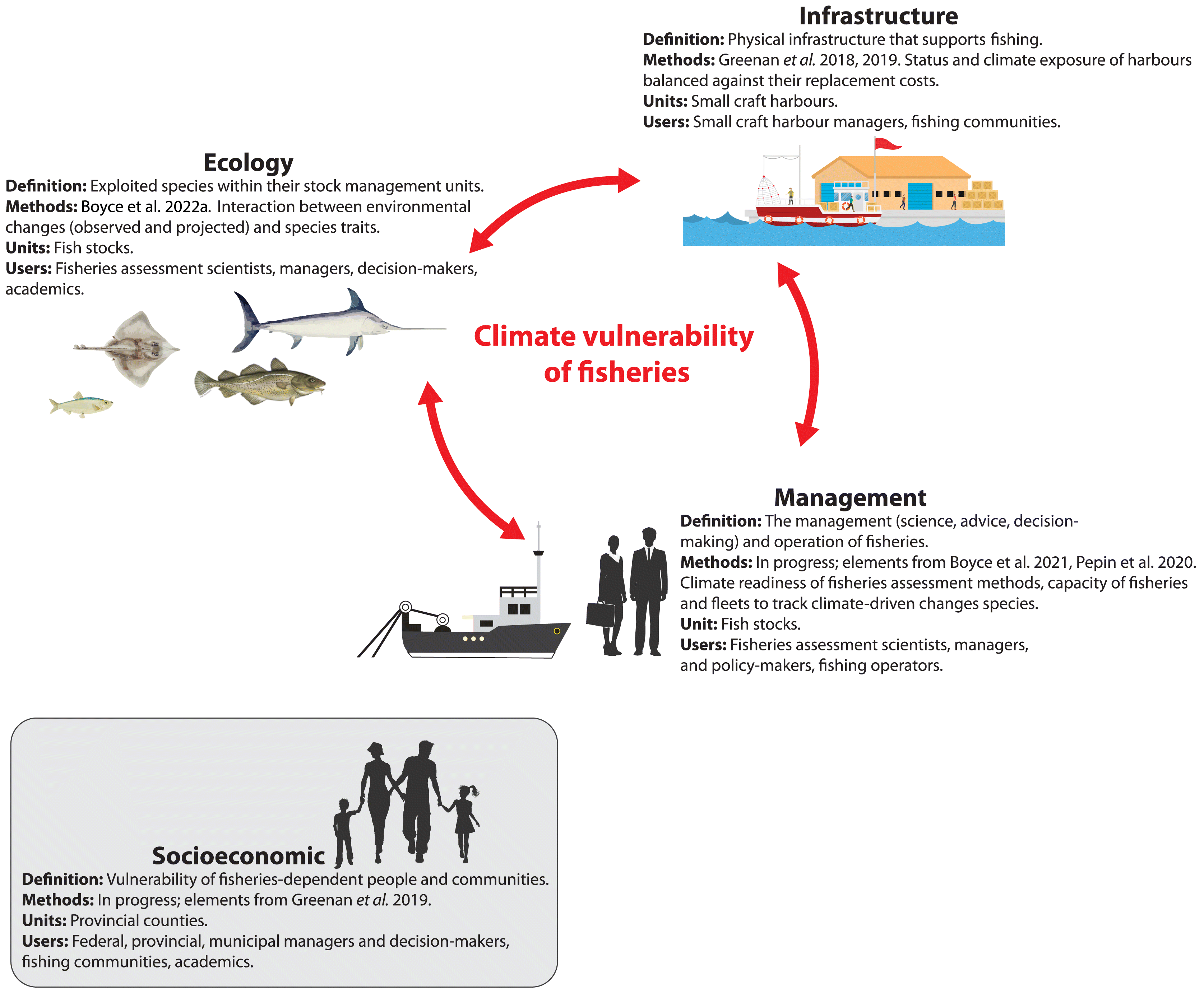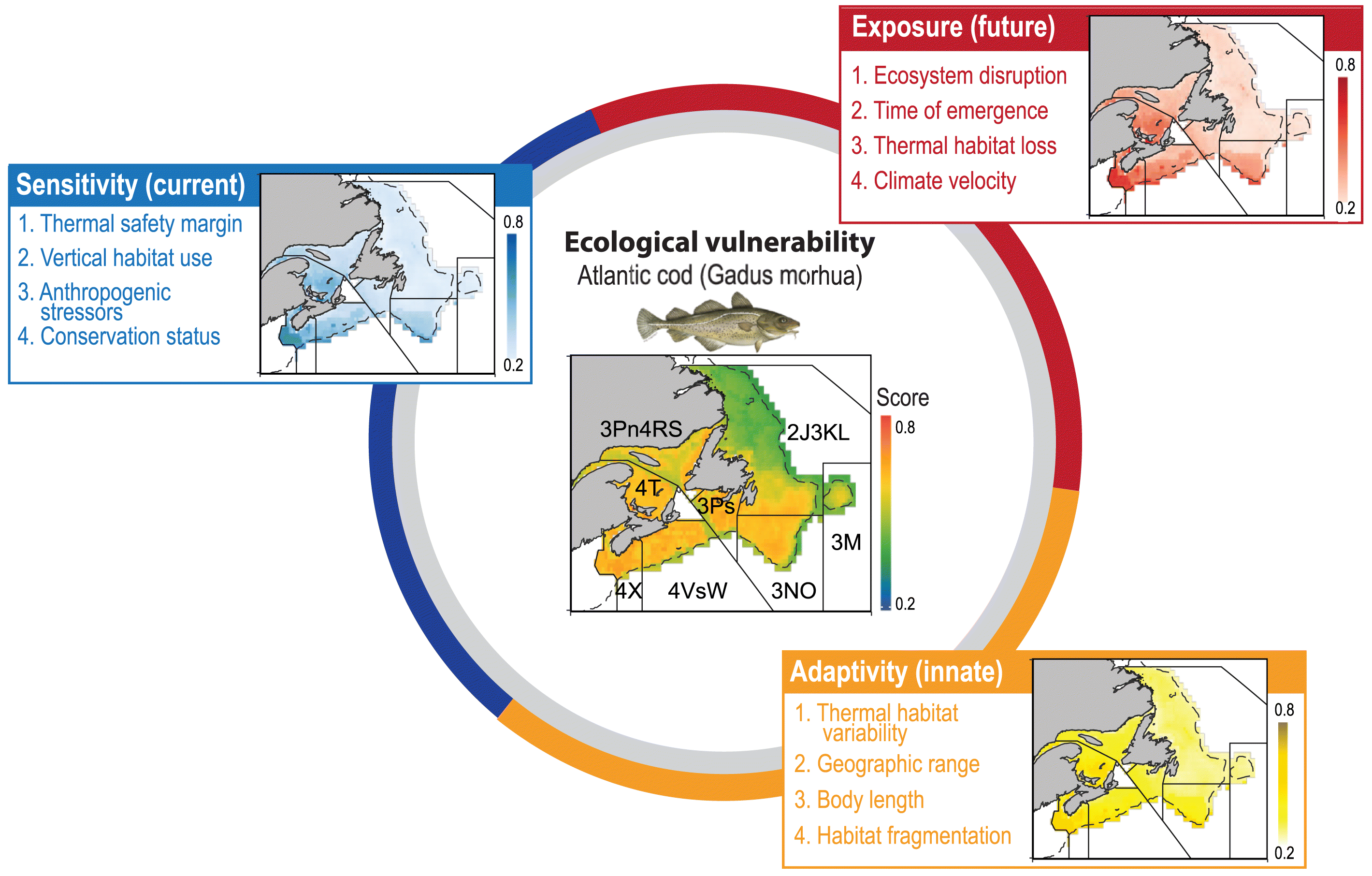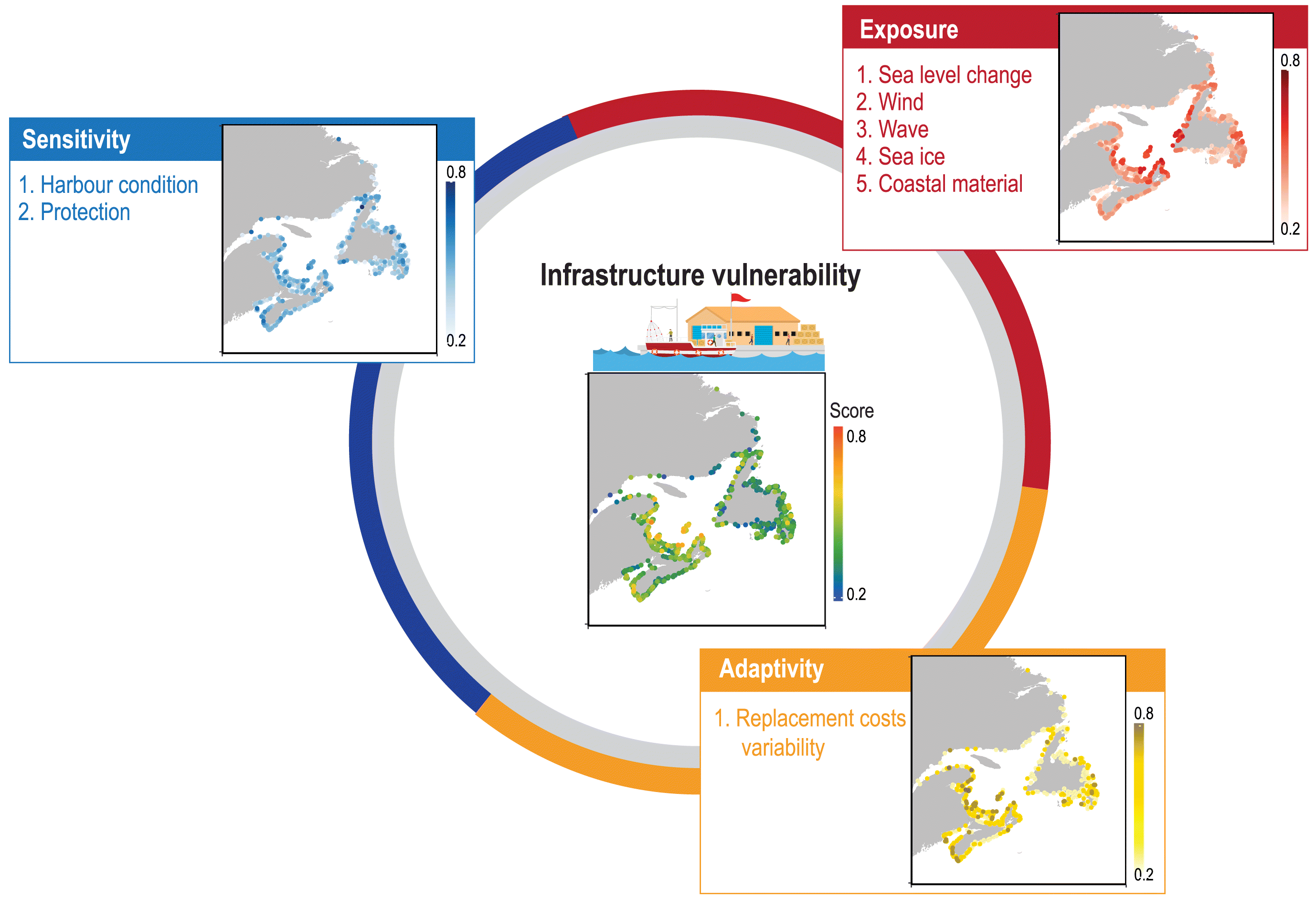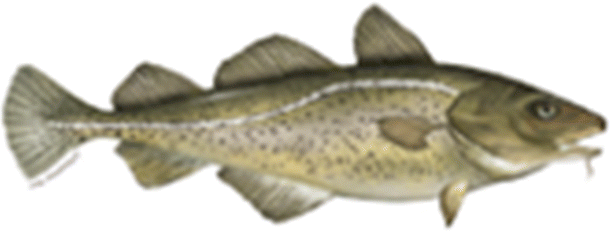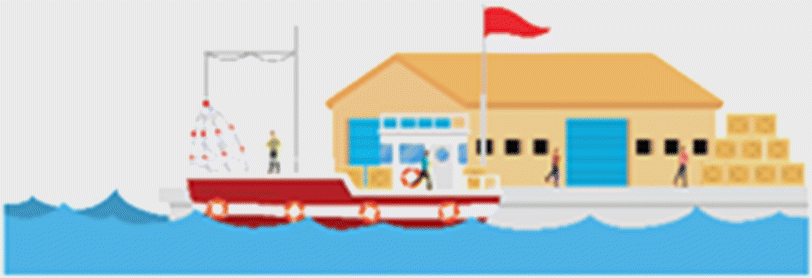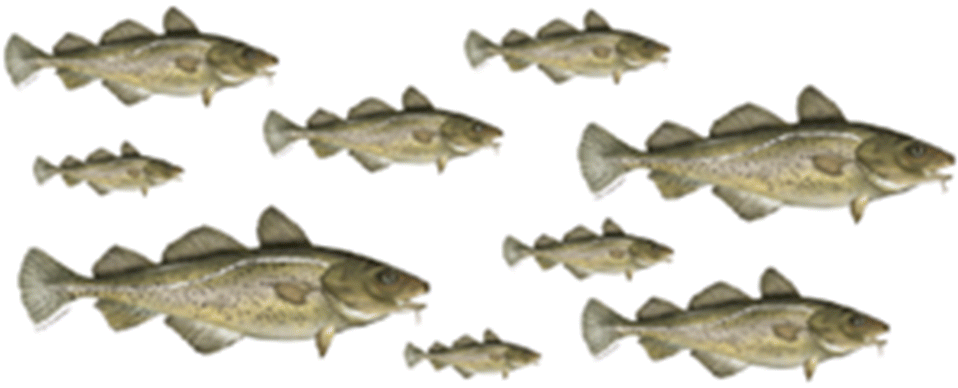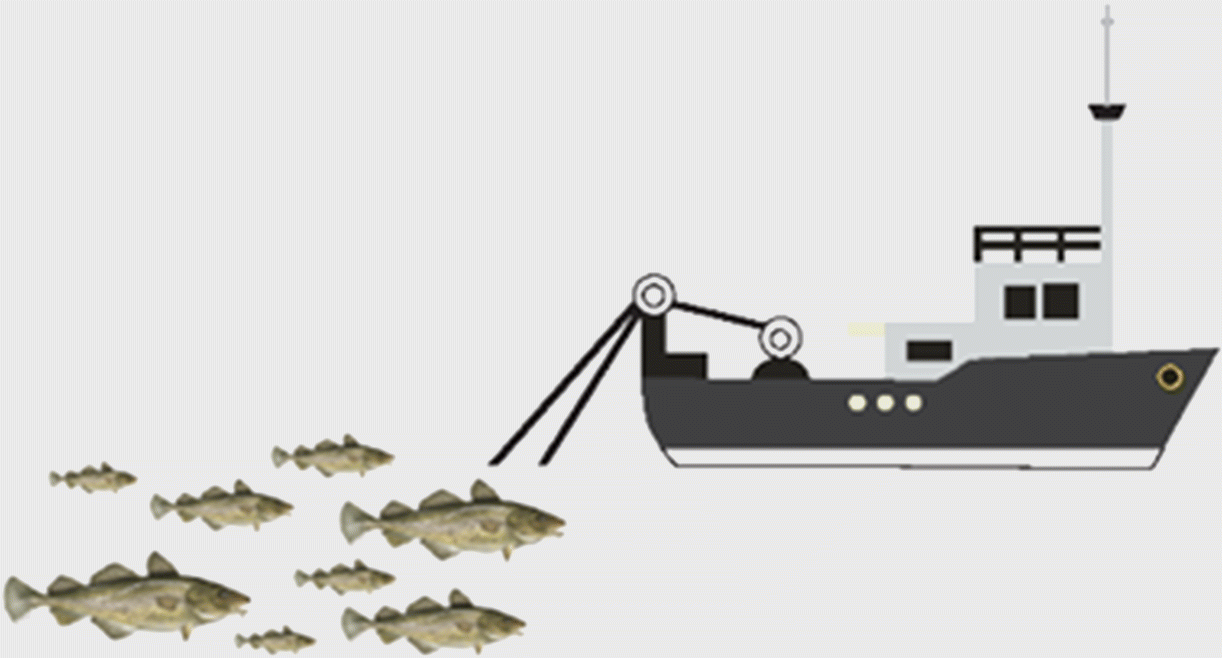Introduction
Globally, climate change is having pervasive impacts on almost all marine life (
Scheffers et al. 2016), affecting the productivity and status of managed fish stocks (
Britten et al. 2016;
Free et al. 2019) and population recovery timelines (
Britten et al. 2017;
Cheung et al. 2022). Having a vast marine territory spanning ∼46° of latitude, Canada is experiencing a broad spectrum of climate impacts on its marine living resources (
DFO 2012;
Bryndum-Buchholz et al. 2020;
Boyce et al. 2021a). Marine ecosystem models suggest that projected warming could lead to higher fisheries productivity in Canada’s Arctic Ocean but would cause reduced productivity across most of Canada’s marine territory by 2100 (
Bryndum-Buchholz et al. 2020;
Boyce et al. 2021a). Moreover, the most severe impacts are projected for high trophic-level species that tend to be among the most economically valuable (
Pontavice et al. 2021). Expert assessments have also suggested that warming and other associated climate changes will significantly impact marine resources, infrastructure, and management capacity throughout Canada’s marine and freshwater basins, and impacts will generally increase over time (
DFO 2012).
The observed and projected adverse climate impacts on Canada’s marine fisheries pose a significant threat to the socioeconomic well-being of Canadians (
Hutchings and Rangeley 2011;
Baum and Fuller 2016;
Boyce et al. 2021a). Fisheries contribute approximately 22% to both employment and income of Canada’s marine economy (
Ganter et al. 2021) and are disproportionately crucial to many coastal regions’ cultures, economies, and prosperity (
Boyce et al. 2021a). For instance, marine sectors make up 1.6% of Canada’s gross domestic product but rise to 30% in Newfoundland and Labrador (
Ganter et al. 2021). Fisheries are critically important to many Indigenous coastal communities in Canada, where they are highly culturally relevant and where seafood consumption can be the primary source of protein (
Baum and Fuller 2016).
Despite the high probability of adverse climate impacts on fisheries and the social and economic disruption that would ensue, Canada lacks a clear overarching climate change adaptation strategy for its fisheries and climate change is not commonly considered in the conservation and management of Canada’s marine living resources (
Boyce et al. 2021a,
2021b;
O’Regan et al. 2021;
Bryndum-Buchholz et al. 2022;
Pepin et al. 2022). The low incorporation of climate change considerations into Canada’s fisheries management strategies could compromise their efficacy leading to poor management outcomes, possible conflicts over fishing resources (
Østhagen et al. 2020), and loss of livelihoods and outmigration (
Hutchings and Rangeley 2011). Further, delaying the implementation of climate-informed fisheries management actions could impair the long-term sustainability of vulnerable species and result in missed opportunities (
Brown et al. 2012). There is an increased urgency to understand how Canadian fisheries are impacted by both long-term secular climate changes and shorter-term climate variability fluctuations to support climate-ready management solutions (
Pinsky and Mantua 2014;
Gattuso et al. 2015;
Busch et al. 2016) and to develop adaptation strategies (
Melvin et al. 2016) to ensure that fisheries remain productive and sustainable.
Here, we present an overview of the Climate Adaptation Framework for Fisheries (CAFF), which we are developing to support climate adaptation and climate readiness in Canadian marine fisheries. The framework is being designed to assess climate vulnerabilities across different aspects of fisheries, including the harvested species, the infrastructures that support fishing, and fisheries management and operation, to understand the barriers to adaptation and how best to overcome them; it seeks to produce output to support climate adaptation across different organizations, regulatory agencies, rights-holders, and stakeholders; it will be reproducible, so fisheries’ vulnerability can be monitored over time to assess progress towards adaptation. The project is initially being piloted for fisheries in the Atlantic region, a climate change hotspot where oceans are warming faster than the global average, and severe climate impacts on fisheries productivity are projected (
Lotze et al. 2019;
Bryndum-Buchholz et al. 2020;
Boyce et al. 2021a). We discuss the development of the CAFF from concept to implementation, including its structure, anticipated outputs, strengths, users, applications, and steps that could enhance its utility. Finally, we discuss how the results could be applied and operationalized to support marine conservation and management decision-making in Canada under climate change.
A vulnerability assessment for Canadian fisheries
At their core, climate change vulnerability assessments (CCVAs) seek to understand the relative or absolute susceptibility of species, ecosystems, infrastructure, nations, economies, and other entities to climate change (
IPCC 2021). However, they can also provide more detailed and nuanced information about how, why, and when vulnerability manifests, which is critical to managing risk and developing adaptation strategies. Specifically, CCVAs can evaluate the likely exposure of entities to hazardous climate changes (exposure), their response to them (sensitivity), and their propensity to be resilient to adverse impacts (adaptivity). CCVAs can also identify barriers to understanding climate change impacts and are widely viewed as an essential component of climate adaptation (
Stortini et al. 2015;
Busch et al. 2016;
Hare et al. 2016;
FAO 2018;
Greenan et al. 2019).
Despite the growing application of CCVAs to species (
Pacifici et al. 2015;
Comte and Olden 2017;
Butt et al. 2022;
Penn and Deutsch 2022 reviewed by
de los Ríos et al. 2018;
Foden et al. 2019), climate vulnerability is far less frequently evaluated in coupled social–ecological systems such as fisheries, particularly in a spatially explicit manner (
Payne et al. 2021). This may be due to the challenges of integrating across the ecological, social, and economic dimensions that affect fisheries’ susceptibility to climate impacts and the associated need for cross-disciplinary approaches. Nevertheless, the ecological, social, and economic components are inextricably connected and unavoidable for systems such as fisheries. Consequently, there is an urgent need to develop robust, integrative, cross-disciplinary approaches that consider ecological, social, cultural, and economic dimensions when evaluating fisheries’ vulnerability to understand how coastal communities will respond to climate changes and develop strategies for their long-term sustainability (
Teh et al. 2017).
The CAFF seeks to evaluate the climate vulnerability of fisheries along three primary axes (
Fig. 1): (1) ecological, (2) infrastructure, and (3) management. Socioeconomic factors are important to understanding the consequences of fisheries’ climate vulnerability for fishing-dependent communities. Communities with higher socioeconomic status and productive, diversified economies can adapt to climate-induced impacts in the fisheries sector with less severe socioeconomic consequences (
Colburn et al. 2016;
Anderson et al. 2017;
Blasiak et al. 2017). However, we are currently unable to robustly evaluate a full suite of socioeconomic indicators within this framework owing to privacy issues in small coastal communities and the challenges of acquiring socioeconomic indicators at the requisite geographic scales (e.g., fish stocks, harbours, or fishing fleets). Until socioeconomic information is available in the requisite form, we will evaluate it separately to allow us to interpret fisheries’ vulnerability in a broader-scale socioeconomic context; similar approaches have been successfully applied elsewhere (
Ekstrom et al. 2015). In the following, we discuss these three axes separately before discussing how they can be integrated and operationalized within the Canadian marine conservation seascape.
Ecological
The climate vulnerability of fish stocks in this framework is primarily determined by the harvested species and is assessed using the Climate Risk Index for Biodiversity (CRIB) (
Boyce et al. 2022a,
2022b). The CRIB is an empirically rooted, spatially explicit framework to assess the relative climate vulnerability on a continuous scale and climate risk on an absolute one for marine species. The CRIB spatially estimates species’ climate vulnerability and risk by integrating 12 climate vulnerability indicators that capture generalized species responses to climate change under different greenhouse gas emission scenarios. The indices are rooted in ecological theory, widely accepted, and validated through peer-review and publication; they capture unique information about ecological responses to climate change and include, for instance, species’ proximity to current (
Stuart-Smith et al. 2015) and projected future (
Trisos et al. 2020) hazardous climate conditions, intrinsic resilience to disturbances (
Cheung et al. 2007), responses to synergistic impacts (
O’Hara et al. 2021), and climate-driven ecosystem disruption (
Urban 2015). The indices are used to calculate species’ climate vulnerability and risk according to three dimensions: the present-day sensitivity to climate change, projected future exposure, and innate potential to adapt (
Fig. 2).
The CRIB framework can be flexibly adapted to various management and decision-making scenarios, utilizes a wide range of data sources, and can be implemented across geographic scales, from coarse global to high-resolution regional and local levels. It is transparent and reproducible and can thus consistently track changing climate vulnerability and risk for species and ecosystems over time. This framework has been used to evaluate the global climate vulnerability and risk for 24,971 marine species at a coarse resolution (1° x 1°) under two contrasting greenhouse gas emission scenarios (SSP5-8.5: high emissions and SSP1-2.6: high mitigation) (
Boyce et al. 2022b). Subsequently, the CRIB was used to evaluate the climate vulnerability and risk for ∼2,000 species and for 90 fish stocks at a moderate resolution (0.25° x 0.25°) across the Canadian North Atlantic Ocean (
Boyce et al. 2022b). This framework can be aggregated across species to examine ecosystem-level patterns.
Fig. 2 shows the outputs from CRIB estimating the climate sensitivity, exposure, adaptivity, and vulnerability for Atlantic cod (
Gadus morhua) across its Atlantic Canadian fisheries management areas under a high emission scenario (SSP5-8.5) to 2100.
Infrastructure
The economic vulnerability of fisheries is assessed using the coastal infrastructure vulnerability index (CIVI). The CIVI evaluates the climate vulnerability of the physical infrastructure that is essential to supporting fisheries across harbours along all coasts of Canada (
Cogswell et al. 2018;
Greenan et al. 2018,
2019). This was developed as a national-scale adaptation tool for the Fisheries and Oceans Canada (DFO) Small Craft Harbours (SCH) programme
1 to provide a relative vulnerability assessment incorporating climate change’s effects (
Greenan et al. 2018). A detailed description of the previous CIVI methodology is in
Greenan et al. (2018,
2019) and
Cogswell et al. (2018).
We redefined the CIVI to be calculated from three sub-indices: climate exposure, sensitivity, adaptivity, and cumulative vulnerability of harbours to ensure that its interpretation is aligned with the approach described by the IPCC (
IPCC 2021) and used in the CRIB (
Boyce et al. 2022b,
2022a). Each sub-index includes one to five component variables scored on a 1 to 5 scale (least vulnerable to most vulnerable) depending on the harbour’s vulnerability to that variable. The variables are scored objectively using clearly defined assessment criteria, resulting in a reproducible assessment. The component variables related to sensitivity and adaptivity are based on data from the recent past as made available from the SCH programme. The individual sub-index scores are calculated as the geometric mean of the constituent variables (
Cogswell et al. 2018), and the final vulnerability index is the geometric mean of the three sub-indices for each harbour on a standardized 0–1 scale.
A previous iteration of the CIVI contained socioeconomic indicators at a coarse geographic scale that were challenging to obtain and assign to individual fishing harbours (
Greenan et al. 2019). Consequently, we omitted the socioeconomic indices. Doing so avoids the aforementioned challenges associated with the socioeconomic indices.
Fig. 3 shows CIVI outputs, estimating the climate sensitivity, exposure, adaptivity, and vulnerability of SCH in Atlantic Canada.
Management
Following previous studies, fisheries management is defined as “
the integrated process of information gathering, analysis, planning, consultation, decision-making, allocation of resources and formulation and implementation, with enforcement as necessary, of regulations or rules which govern fisheries activities to ensure the continued productivity of the resources and the accomplishment of other fisheries objectives” (
FAO 1997). Decisions about how fisheries are managed and operated are critical to sustainability, but often, the scientific or formal advice on harvested species overlooks climate vulnerability, making it difficult for fisheries management to implement adaptation strategies (
Boyce et al. 2021a,
2021b;
Bryndum-Buchholz et al. 2021;
Pepin et al. 2022). Implementing management strategies that consider climate variability and change can sometimes compensate for adverse climate impacts or amplify positive ones (
Le Bris et al. 2018;
Hilborn et al. 2020). Because of this, regional management organizations, such as the Northwest Atlantic Fisheries Organization, international organizations, such as the Food and Agriculture Organization, science organizations, such as the International Council for the Exploration of the Sea, and scientists are developing fisheries management approaches that incorporate climate change (
Ortega-Garcia et al. 2003;
Busch et al. 2016;
Koen-Alonso et al. 2019;
Bahri et al. 2021).
Our approach builds and expands on those of
Pepin et al. (2022) and Boyce et al. (
2021b,
2021a) that quantified the extent to which climate variability and change and ecosystem factors are included in the scientific assessment and provision of advice for Canadian fisheries. However, we will use a structured survey developed in partnership with DFO scientists in the Pacific and Maritimes regions, a non-governmental conservation organization, and academia. The survey is conceptually similar to the Sustainability Survey for Fisheries (SSF
2), which has been used to track the performance of fisheries across Canada since 2015 as part of the DFO Sustainable Fisheries Framework (SFF). Whereas the SSF addresses the general status of Canadian fisheries, our survey will expand to address details of fisheries management under climate change. Namely, it will assess if and how climate considerations are factored into fisheries management advice and decision making, aspects related to the transparency and rigor of management, and will identify barriers and resources that are needed to support climate-ready management (
Woods et al. 2021). Like the SSF, the survey will be distributed to the appropriate DFO personnel responsible for each DFO-managed stock to assess if and how climate variability and change are considered across the various steps in their management, including (1) setting objectives for the stock, (2) collecting monitoring data, (3) assessing the stock status, (4) providing science and formal advice, and (5) decision-making. The survey will be relatable to the SSF, enabling users to combine the two for greater utility. Where answers indicate a lack of climate consideration, respondents will be asked to identify barriers to adaptation and resources that would most assist them in better incorporating climate considerations. This management-operational axis is essential to climate adaptation efforts. It will provide a means for fisheries scientists and decision-makers to communicate perceived hurdles to climate adaptation strategies that are actionable on the shorter timescales at which stocks are assessed, thus facilitating a more customized stock-specific approach. Responses to the survey will be a mix of quantitative (numerical) and qualitative (written) and will be scored numerically using objective criteria to identify themes in qualitative responses.
Climate vulnerability in support of fisheries climate adaptation
Canadian fisheries management faces a formidable challenge. It must balance multiple objectives to ensure that marine populations remain healthy and economies and communities are productive while adhering to the many policies that govern fisheries. Further complicating matters is the added need to incorporate climate and ecosystem considerations throughout the management process. The overarching intent of our CAFF is to support the inclusion of climate variability and change into the management process and help to ease the burden on fisheries scientists, managers, and decision-makers to fulfil their mandate of safeguarding sustainable fisheries. To further this objective, the framework will strive to produce output that can support climate-considered decision-making across different organizations, regulatory agencies, rights-holders, and stakeholders. The framework will seek to incorporate core design principles to further this objective, namely to be (i) actionable, (ii) useful to multiple users, and (iii) practical, comprehensive, and reproducible.
For the CAFF to effectively support fisheries adaptation planning, its output must be in a format that can be quickly and practically helpful to end-users and decision-makers. The outputs should translate into tangible actions that meaningfully reduce the climate risk for fisheries and enhance their adaptation. To this end, the outputs from the CAFF could be helpful to strategic planning and mobilizing limited climate adaptation resources (e.g., funding, ship-time, human resources) by, for example, identifying species and locations that are critically vulnerable as priorities for climate adaptation. For instance, both individual and integrated outputs from CAFF could be used in a “Scenario-planning” process (
Planque et al. 2019;
Frens and Morrison 2020), which allows multi-stakeholders to frame the uncertainty associated with climate change by considering the most likely future outcomes, and then listing options that optimize a sustainable outcome. Such an approach allows people to plan and prepare and even consider changes to management (e.g., seasonal changes, area changes) to accommodate the anticipated climate change. For instance, where a dominant fishery is highly vulnerable to climate change, actions to diversify the fishery could be explored. Adaptation resources could include climate-informed stock assessment and advice, dynamic management strategies, and (or) targeted time-area closures of climate-vulnerable habitats (
Woods et al. 2021). Given its ability to provide output flexibly at fine spatial scales or for individual fishing stocks and fleets, our framework could also support fisheries decision-making at the tactical and spatial scales at which most fisheries operate.
Because the priorities, objectives, and mandates among different organizations and regulatory agencies, within regulatory agencies and among stakeholders, will vary, the framework is designed to be flexible and modular. This means that climate vulnerability can be evaluated in multiple ways to meet the diverse needs of fishery stakeholders, decision-makers, and others (
Table 1). For instance, whereas policy-makers and strategic planners may be interested in the cumulative climate vulnerability across all fisheries to support the development of national adaptation strategies and allocate needed resources, fisheries scientists and the fish industry may care more about the vulnerability of individual fishing fleets. In contrast, provincial or municipal planners and coastal communities may want to know how and why particular harbours under their jurisdiction are vulnerable. The framework can provide useful outputs to different end-users by adopting a modular approach.
The CAFF can support decision-making in different sectors, yet its most direct relevance is tactical fisheries management. Canada’s fishery stock assessments rarely incorporate climate considerations into providing scientific advice (
Boyce et al. 2021a,
2021b;
Pepin et al. 2022). The climate vulnerability ecological outputs from our framework could be included in the stock assessment process to provide knowledge about climate threats to commercial species in a standardized and consistent manner to support climate-informed advice and decision-making. Undoubtedly, many innovative approaches are needed to integrate climate considerations into fisheries assessment and advice quantitatively. CAFF can contribute to that; it is a rapid, cost-effective approach that can provide valuable information about climate impacts in a standardized and spatially explicit manner in situations where there currently is not any to support and inform decision-making. Incorporating climate ecological vulnerability into the stock assessment process would help reduce the uncertainty about how the stock responds to climate change. Also, fishery managers may identify opportunities to diversify a regional fishery to include more commercial fish at low vulnerability while alleviating the fishing pressure on those more vulnerable. Further, its modularity enables the framework to provide more detailed, nuanced climate vulnerability information contained in the individual indices. For instance, the time of climate niche emergence index (ToE) contained within the CRIB carries information about when and where exploited species are projected to become stressed by climate; the ToE could provide assessment scientists and managers with essential timelines for implementing climate adaptation strategies and identify areas of rapid climate impact onset or of climate refugia.
Lastly, the CAFF is practical, comprehensive, and reproducible to facilitate decision-making. Rather than relying on a single index, the framework considers >20 components that more comprehensively capture unique information about how exploited species, marine infrastructure, and management approaches make fisheries vulnerable to climate change. This holistic approach defines fisheries’ vulnerability as the accumulation of these different components rather than treating them in isolation. The framework is reproducible, meaning fisheries’ vulnerability can be monitored over time to assess progress towards climate-ready fisheries in Canada. Finally, the framework is practical: it is transparent, easy to implement, yields interpretable standardized outputs, can be flexibly adapted, and can be applied rapidly and cost-effectively.
Caveats and future directions
Fisheries are complex social–ecological systems requiring any climate vulnerability framework to make assumptions. First, like most climate vulnerability analyses (
Pacifici et al. 2015;
Comte and Olden 2017;
de los Ríos et al. 2018;
Foden et al. 2019;
Albouy et al. 2020), ours uses surface temperature as the primary metric of climate change, yet additional factors may also affect species’ responses, including changes in dissolved oxygen and pH, mixing and nutrient flux, or altered biotic interactions. Second, our framework focuses on the climate vulnerability of fish stocks across their management units and does not account for migrations or range expansions outside these units. It thus represents the spatially varying vulnerability of a stock in terms of climate-driven extirpation for each part of its management unit. Third, our framework uses spatially resolved catch and SCH data; as these data sources are not presently available for Indigenous fishers, we cannot estimate climate vulnerability for Indigenous fishers or harbours at this time. Fourth, the component variables for the CIVI exposure sub-index are a combination of current conditions/climatology (coastal materials, wind speed, wave height), historical trends (sea ice change), and future projections (sea level rise). We are exploring whether Coupled Model Intercomparison Project version 6 (CMIP6) model projections could be used for some of the exposure variables and will include these in CAFF when there is sufficient confidence in the variables or a suitable approach to account for projection uncertainty. Lastly, as discussed, socioeconomic data are not available at the level of fishing harbours that our framework would require and are often unavailable due to privacy rules. We are exploring different approaches to overcome these challenges, for instance, associating socioeconomic data to individual harbours probabilistically, but have yet to find a suitable solution. In the interim, we intend to intersect fisheries’ climate vulnerability with socioeconomic factors more broadly (e.g., larger statistical units associated with multiple harbours within them), thereby providing some insight into climate change’s possible social and economic repercussions for fishing-dependent communities. In this context, the socioeconomic consequences of climate-induced changes in the fisheries sector would be more severe for coastal communities that catch less seafood and rely heavily on fishing (e.g.,
Anderson et al. 2017;
Blasiak et al. 2017). Similarly, how fisheries operate – the size of vessels, the gear they deploy, the distance they travel to fish, when and where they are allowed to fish, and the regulatory rules – affect their susceptibility to climate impacts. For instance, fishers aboard small vessels using fixed gear that must operate across smaller regulatory areas, fish in specific seasons, and target single species are poorly positioned to resist and adapt to climate-driven changes in their target species (
Payne et al. 2021) and could be identified as priorities for climate adaptation. We are evaluating approaches to assess these aspects of fisheries’ vulnerability. While acknowledging the limitations of the CAFF framework, we also point out that it is the first of its kind in Canada and represents an essential baseline upon which to build and improve using new data and knowledge.
Conclusions
Climate change is increasingly a source of uncertainty in fisheries (
FAO 2018), yet understanding the climate vulnerability of fisheries can help develop possible strategies to hedge against this uncertainty (
Woods et al. 2021). We describe the CAFF, a pilot project we are developing to support adaptive decision-making in Canada’s fisheries under climate change. The CAFF builds on studies that have evaluated the vulnerability of individual species (
Stortini et al. 2015;
Boyce et al. 2022a,
2022b) and the DFO SCH infrastructure supporting fisheries (
Greenan et al. 2018,
2019), and will take a pragmatic survey-based approach as it builds on recent studies (
Boyce et al. 2021a,
2021b;
Pepin et al. 2022) to evaluate the climate readiness of the management and operation of fisheries. The CAFF is being developed as a pilot project in Atlantic Canada, yet we anticipate that much if not all of it can eventually be applied nationally. The ecological axis has been successfully applied globally (
Boyce et al. 2022b) and regionally (
Boyce et al. 2022a), the infrastructure axis is available nationally (
Greenan et al. 2018,
2019), and the management and operation axis can, in theory, also be applied nationally. Moving forward, we hope that the CAFF can be enhanced and broadened from assessing relative climate vulnerability to absolute climate risk to strengthen its ability to support applied decision-making. For this to occur, the indices would need to be evaluated quantitatively and interpreted on an absolute risk scale (
IUCN 2021;
Boyce et al. 2022b).
